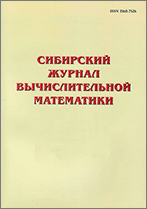Sibirskii Zhurnal Vychislitel'noi Matematiki, 2009, Volume 12 , Number 4 , Pages 361–374
(Mi sjvm132)
This article is cited in 7 7
Statistical simulation methods for a nonhomogeneous Poisson ensemble T. A. Averina ab a Institute of Computational Mathematics and Mathematical Geophysics (Computing Center), Siberian Branch of the Russian Academy of Sciences b Novosibirsk State University, Novosibirsk
Abstract:
In this paper, some Monte-Carlo methods for modeling homogeneous and nonhomogeneous Poisson ensembles are offered. Generalization of the Maximum Cross-section Method is constructed and proved for modeling nonhomogeneous Poisson ensembles of points.
Key words:
Poisson random process, Poisson ensemble, stochastic differential equations, Monte-Carlo methods.
Received: 04.12.2008Revised: 03.02.2009
Citation:
T. A. Averina, “Statistical simulation methods for a nonhomogeneous Poisson ensemble”, Sib. Zh. Vychisl. Mat. , 12 :4 (2009), 361–374 ; Num. Anal. Appl. , 2 :4 (2009), 289–301
Linking options:
https://www.mathnet.ru/eng/sjvm132 https://www.mathnet.ru/eng/sjvm/v12/i4/p361
3
CITATIONS
3
Total citations
1
Recent citation
0.68
Field Citation Ratio
n/a
Relative Citation Ratio
Statistics & downloads :Abstract page: 714 Full-text PDF : 342 References: 71 First page: 19




 Contact us:
Contact us: Terms of Use
Terms of Use
 Registration to the website
Registration to the website Logotypes
Logotypes








 Citation in format
Citation in format 
